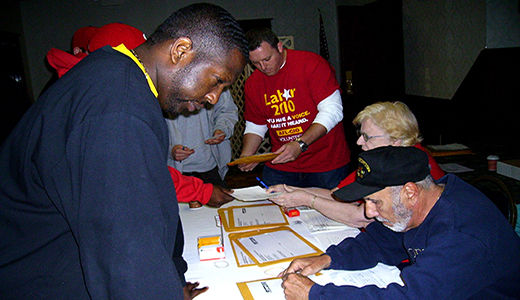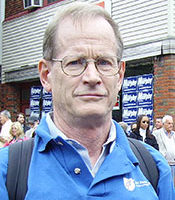
PHILADELPHIA – The Pennsylvania labor movement is in the midst of a determined effort to both bring its issues forward in the 2010 election – and to influence the outcome. The latest poll results, showing Democrat Joe Sestak pulling even and then slightly ahead of right-wing Republican Pat Toomey, indicate that the campaign is getting results. This has been a challenge due to the political geography of the Keystone State.
Sestak, a member of Congress from a suburban Philadelphia district, is well known in the state’s heavily populated southeast region, but he has had to work to increase his name recognition in the Pittsburgh area and in the west. The challenge facing gubernatorial candidate Dan Onorato has been the reverse. Onorato, a former Allegheny County commissioner, is better known in western Pennsylvania than in the east. According to the AFL-CIO’s Liz McElroy, labor is one force that can bring the state’s electorate together.
“We’re everywhere, not just in the east or the western part of the state,” McElroy said. For instance, AFTPA (teachers union), according to its political director Dee Tancredi, has six phone banks operating across the state, including areas like Pittsburgh, Scranton and Philadelphia.
McElroy, statewide coordinator of the Pennsylvania AFL-CIO’s get-out-the-vote effort, explained what she felt was key to the movement’s ability to influence election outcomes. She told the World, “Our program works because we talk to our members about issues. We talk to them one on one on labor walks and through phone calls. We contact them at their work places.”
The weekend of Oct. 2 tested the strength and the scope of the movement’s resolve. Faced with the choice of sending members to the One Nation March in Washington or knocking on doors at home, many unions decided to do both. While several unions sent multiple buses to DC carrying both union members and members of community organizations, the local labor walks went on. Several unions, including AFSCME, SEIU, the teachers and the autoworkers, sponsored buses that were open to their members and to others in the community. The Philadelphia Federation of Teachers sent 10 buses; AFSCME Local 1199C sent a reported 20; buses sent by the two AFSCME District Councils (33 and 47) added to the total.
Commenting on the level of cooperation between labor and community, statewide One Nation Coordinator Pat McNamara told the World that given that “it was an effort put together with bubble gum and shoe string, we did a phenomenal job.”
As the campaign enters it final days, efforts to have as many contacts as possible with each member are intensifying. Union leaders and activists here believe that the record from recent elections shows that members value and respond to information from their union and that the union vote could account for as much as one third of the total.
Image: Ben Sears/PW










